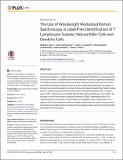Files in this item
The use of Wavelength Modulated Raman Spectroscopy in label-free identification of T lymphocyte subsets, Natural Killer cells and Dendritic cells
Item metadata
| dc.contributor.author | Chen, Mingzhou | |
| dc.contributor.author | McReynolds, Naomi | |
| dc.contributor.author | Campbell, Elaine Catherine | |
| dc.contributor.author | Mazilu, Michael | |
| dc.contributor.author | Barbosa, Joao | |
| dc.contributor.author | Dholakia, Kishan | |
| dc.contributor.author | Powis, Simon John | |
| dc.date.accessioned | 2015-05-28T15:10:06Z | |
| dc.date.available | 2015-05-28T15:10:06Z | |
| dc.date.issued | 2015-05-20 | |
| dc.identifier | 179438713 | |
| dc.identifier | cb9837b0-4787-4304-9cab-536d65fa418f | |
| dc.identifier | 84930620601 | |
| dc.identifier | 000354921400025 | |
| dc.identifier.citation | Chen , M , McReynolds , N , Campbell , E C , Mazilu , M , Barbosa , J , Dholakia , K & Powis , S J 2015 , ' The use of Wavelength Modulated Raman Spectroscopy in label-free identification of T lymphocyte subsets, Natural Killer cells and Dendritic cells ' , PLoS One , vol. 10 , no. 5 , e0125158 . https://doi.org/10.1371/journal.pone.0125158 | en |
| dc.identifier.issn | 1932-6203 | |
| dc.identifier.other | ORCID: /0000-0002-6190-5167/work/47136399 | |
| dc.identifier.other | ORCID: /0000-0003-4218-2984/work/60195330 | |
| dc.identifier.uri | https://hdl.handle.net/10023/6705 | |
| dc.description | This work was funded by a Cancer Research United Kingdom, Engineering and Physical Sciences Research Council (grant EP/J01771X/1), Medical Research Council and Department of Health England Imaging Programme (MC, MM KD), and by A European Union FAMOS project (FP7 ICT, 317744) to KD. | en |
| dc.description.abstract | Determining the identity of cells of the immune system usually involves destructive fixation and chemical staining, or labeling with fluorescently labeled antibodies recognising specific cell surface markers. Completely label-free identification would be a significant advantage in conditions where untouched cells are a priority. We demonstrate here the use of Wavelength Modulated Raman Spectroscopy, to achieve label-free identification of purified, unfixed and untouched populations of major immune cell subsets isolated from healthy human donors. Using this technique we have been able to distinguish between CD4+ T lymphocytes, CD8+ T lymphocytes and CD56+ Natural Killer cells at specificities of up to 96%. Additionally, we have been able to distinguish between CD303+ plasmacytoid and CD1c+ myeloid dendritic cell subsets, the key initiator and regulatory cells of many immune responses. This demonstrates the ability to identify unperturbed cells of the immune system, and opens novel opportunities to analyse immunological systems and to develop fully label-free diagnostic technologies. | |
| dc.format.extent | 3970099 | |
| dc.language.iso | eng | |
| dc.relation.ispartof | PLoS One | en |
| dc.subject | Raman spectroscopy | en |
| dc.subject | Dendritic cells | en |
| dc.subject | Natural killer cells | en |
| dc.subject | T Lymphocytes | en |
| dc.subject | R Medicine | en |
| dc.subject | QC Physics | en |
| dc.subject | DAS | en |
| dc.subject | SDG 3 - Good Health and Well-being | en |
| dc.subject.lcc | R | en |
| dc.subject.lcc | QC | en |
| dc.title | The use of Wavelength Modulated Raman Spectroscopy in label-free identification of T lymphocyte subsets, Natural Killer cells and Dendritic cells | en |
| dc.type | Journal article | en |
| dc.contributor.sponsor | European Commission | en |
| dc.contributor.sponsor | EPSRC | en |
| dc.contributor.institution | University of St Andrews. School of Medicine | en |
| dc.contributor.institution | University of St Andrews. Biomedical Sciences Research Complex | en |
| dc.contributor.institution | University of St Andrews. School of Physics and Astronomy | en |
| dc.identifier.doi | https://doi.org/10.1371/journal.pone.0125158 | |
| dc.description.status | Peer reviewed | en |
| dc.identifier.url | http://journals.plos.org/plosone/article?id=10.1371/journal.pone.0125158#sec016 | en |
| dc.identifier.grantnumber | 317744 | en |
| dc.identifier.grantnumber | EP/J01771X/1 | en |
This item appears in the following Collection(s)
Items in the St Andrews Research Repository are protected by copyright, with all rights reserved, unless otherwise indicated.

